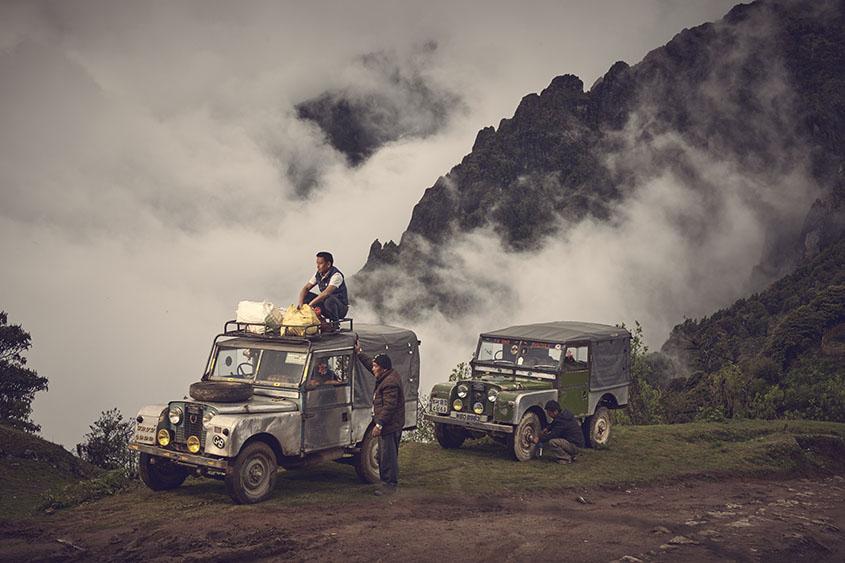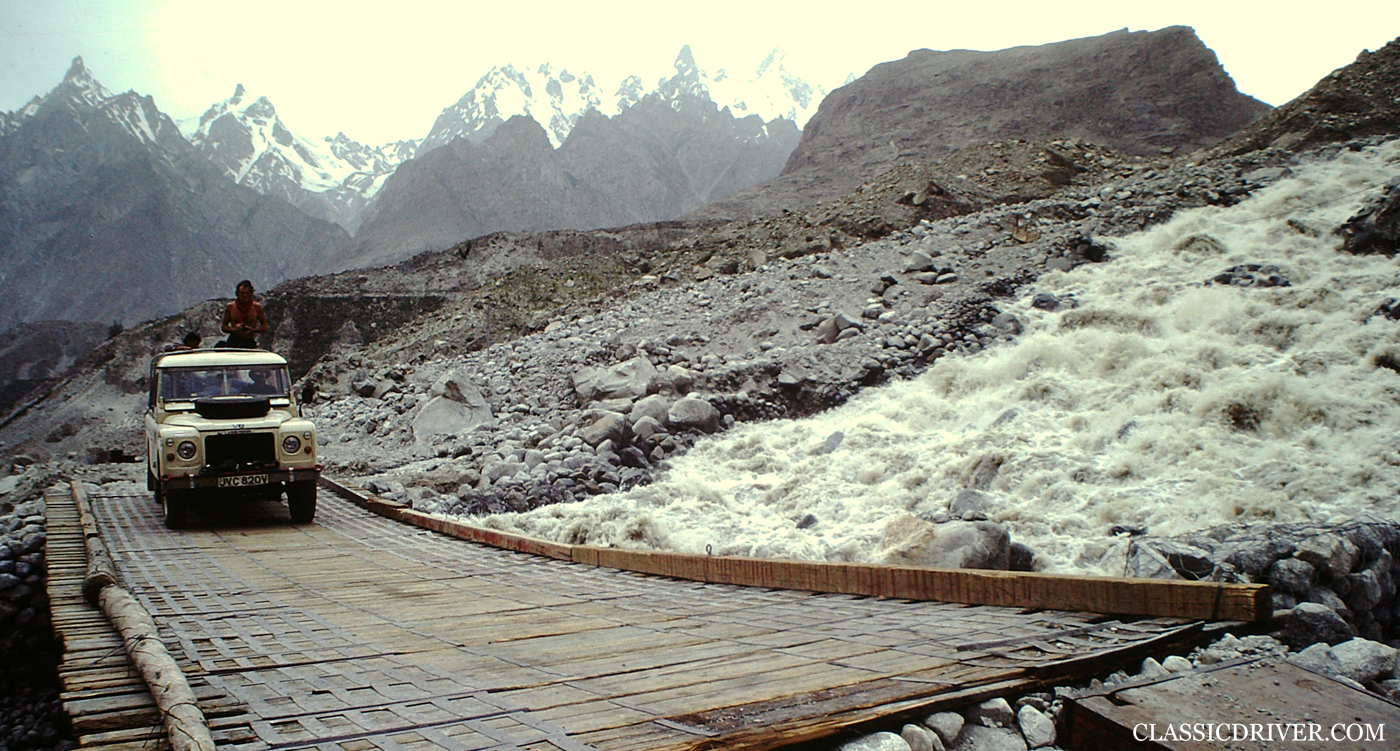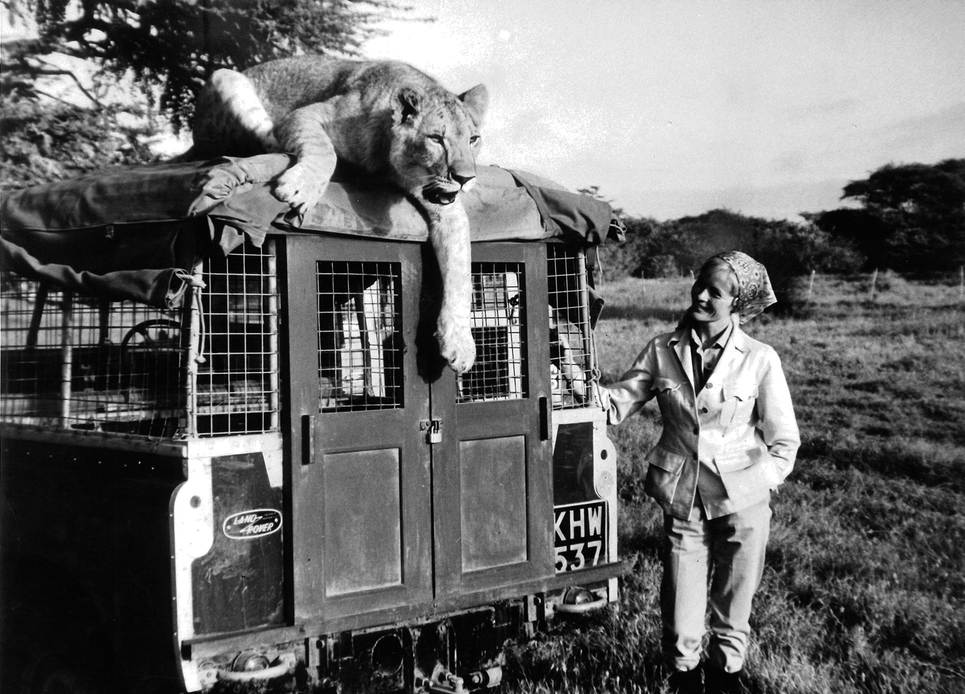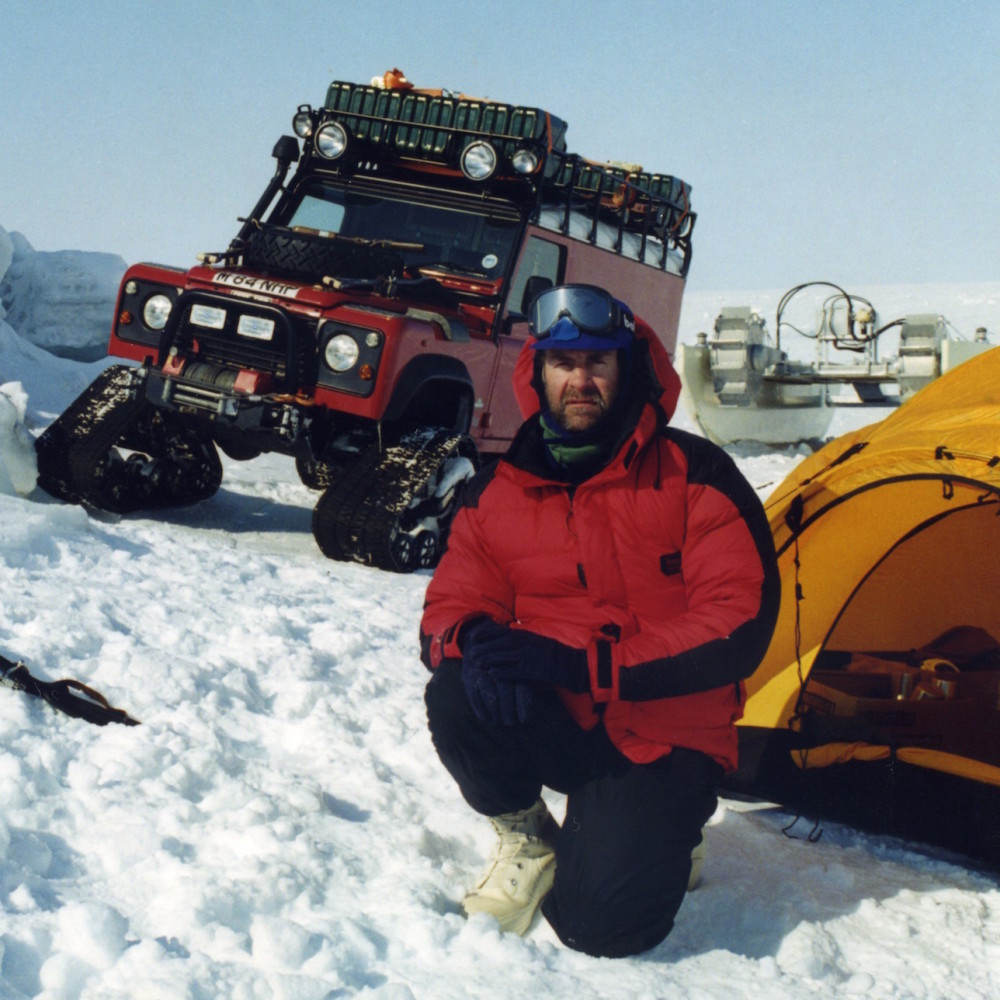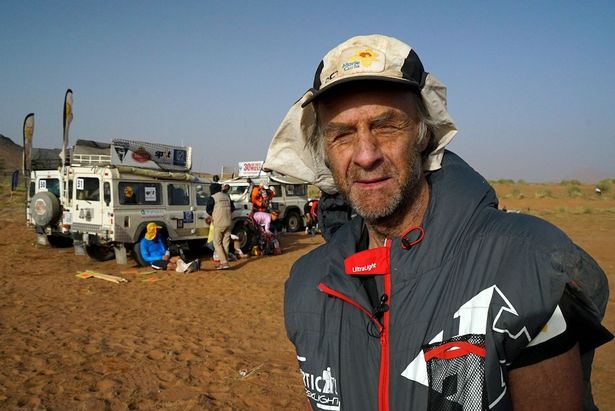An illustrated Essay describing how, since the outset, the reporting of the extreme antics of Land Rovers around the world enabled promotion of the image of the Land Rover as the first choice 4×4 for all occasions – fit and capable for anything asked of it.
From the earliest times the Rover Motor Company knew that the best advertisement for their new creation, the Land Rover, was to have it reported on being driven in the far flung corners of the World. For obvious reasons, the further and wilder the location the better.
The first truly Global expedition incorporating the Land Rover was the famed overland trip from London to Singapore embarked upon by two Series I 86″ Station Wagons. On 1st September 1955 six college students from the U.K. set out from London. Six months later, they arrived in Singapore, completing an historic journey, officially known as the “Oxford and Cambridge Far Eastern Expedition”. The trip would later come to be known to us as The First Overland.
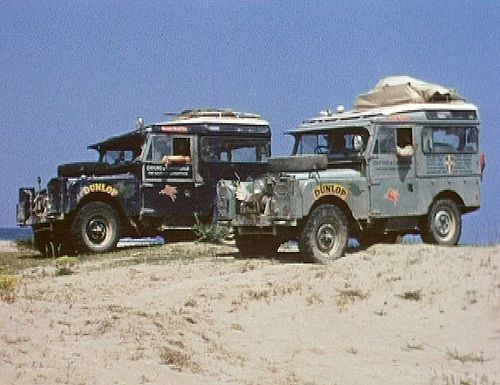
Unbelievably one of those vehicles (the one on the left) ended up being used as a chicken coup on a small remote island in the South Atlantic. In any normal situation one would expect that to be how it ended its days – in sad obscurity. But not a proud Land Rover. What do they say; “Landys never die, they are simply hanging around waiting to be rescued“. Pedigree will out.
Existence of this important vehicle thankfully became recognised and its recovery and restoration was assured. Then, after much blood sweat and tears, on Sunday, 25th August 2019 — almost 64 years to the day from the start of the first trip— that vehicle, being one of the original two, set off to make the journey once again, this time in reverse. Instrumental in making this happen was 87 year old Tim Slessor, one of the original six students who embarked on the original outbound trip. The return journey became dubbed “The Last Overland.” This photograph shows this infatigable old timer dodging the London traffic during the closing stage of this epic trip . She looks as spritely today as she did the day she first left London all those years before!
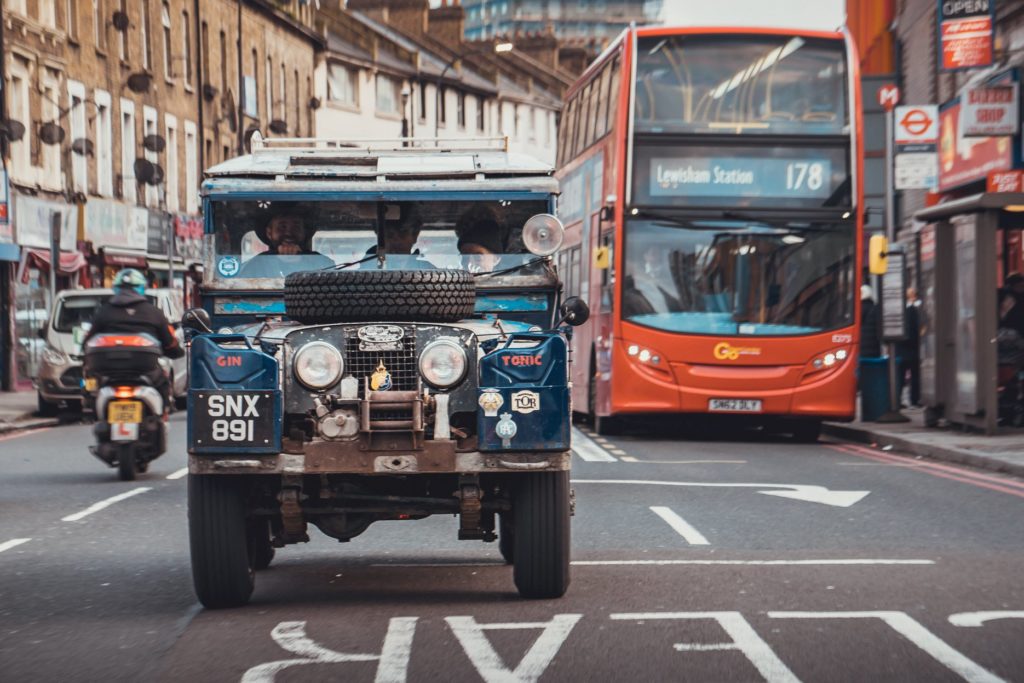
From celebration to tradegy
Another notable example of a newsworthy placement that benefitted Land Rover hugely was the Series II that was used by Joy and George Adamson in the course of their work in Kenya, Africa, following Joy’s infamous adoption of Elsa an orphaned lion cub which was then bred to be released back into the wild. The story captured the attention of the nation throughout the late 50’s / early 60’s. Images from Joy’s famous book, TV coverage and subsequent film (all entitled ‘Born Free’) would be incomplete without the Adamson’s Series II in the shot. Sadly a Land Rover featured right up to the very end of this sad story. Long after the violent death of Joy at the hands of a disgruntled employee, George also met a tragic end when attacked by poachers in the Kenyan bush while driving in his later Series III. That (now restored) Land Rover is still on public display in Kenya alongside its original door exhibiting the bullet holes left by this unprovoked attack.
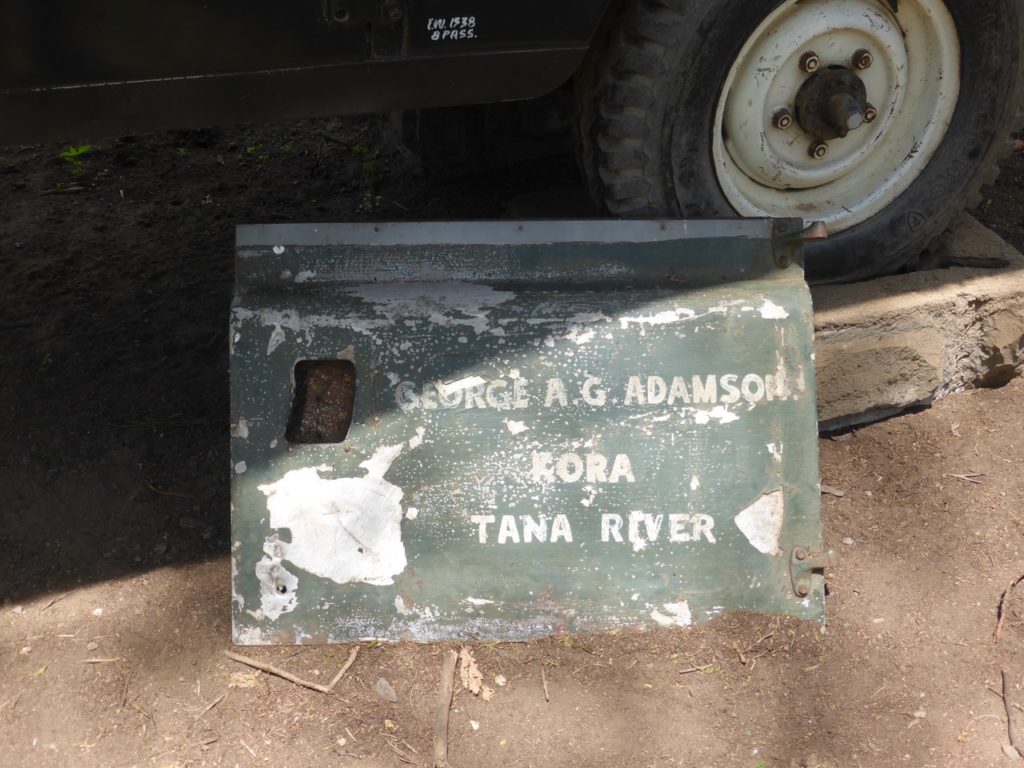
But thankfully people’s recollections are of happier days when lions were regularly photographed draped over the Adamson’s Series II.
Land Rover never lost their gratitude for this wonderful PR opportunity. As late as 2013 they reconfirmed their longstanding Global Conservation Partnership with the Born Free Foundation, which had become one of the World’s foremost wildlife charities having been inspired by the telling of the story of Joy Adamson and, the real star, Elsa. As part of their commitment, Land Rover deployed loan Defenders over three continents to further the work of the Foundation.
Exploration
Throughout the 60’s and 70’s a great number of enterprising Brits were doing their best to make the World a smaller place. And the ‘Go Anywhere’ Land Rover was never far from the action. Perhaps one of the most famous (and certainly the most charismatic) of those explorers was Ranulph Finnes. Known as “Ran” to those close to him, he was declared by the Guinness Book of Records in 1984 as “The Greatest Living Explorer.” And during those exploits he was never far from ‘The Greatest Living Vehicle’, a Land Rover.
Over an unbroken 30 year period Ranulph was seeking out extreme hot, and later the coldest, places on Earth to explore and conquer. Land Rover were more than encouraging whenever their vehicle was the chosen means of transport – that being every occasion where land travel was the order of the day. Ranulph came to love and respect Land Rovers during his SAS years when he was deployed in support of the Omani Army. He has explained to us that, “Combat in the dessert taught me that when your life literally depends on it, the Land Rover is the obvious vehicle of choice”. It is no surprise therefore that in more recent years he has been one of the highest profile Land Rover ambassadors.
From Exploration to Adventure
Valuable though such initiatives were in promoting the Land Rover as literally the ‘Go Anywhere’ vehicle, in marketing terms a given project had an inevitable shelf life. Once the 80’s arrived the need was recognised to associate Land Rover with a more lasting image as the Globe’s chosen lifestyle vehicle. The company achieved this by providing, through sponsorship, the spine of some of the most recognisable series of competitive adventure drives. Perhaps the most renowned example being the Camel Trophy.
Promoting the values of adventure, exploration and freedom the Camel Trophy was an annual event held over an unbroken 20 year period commencing in 1980. Teams of two men and their vehicles were pitted against the toughest terrain that the Earth could lay before them. What better event for Land Rover to sponsor than what was widely accepted as ‘the toughest test of endurance for man and vehicle.’
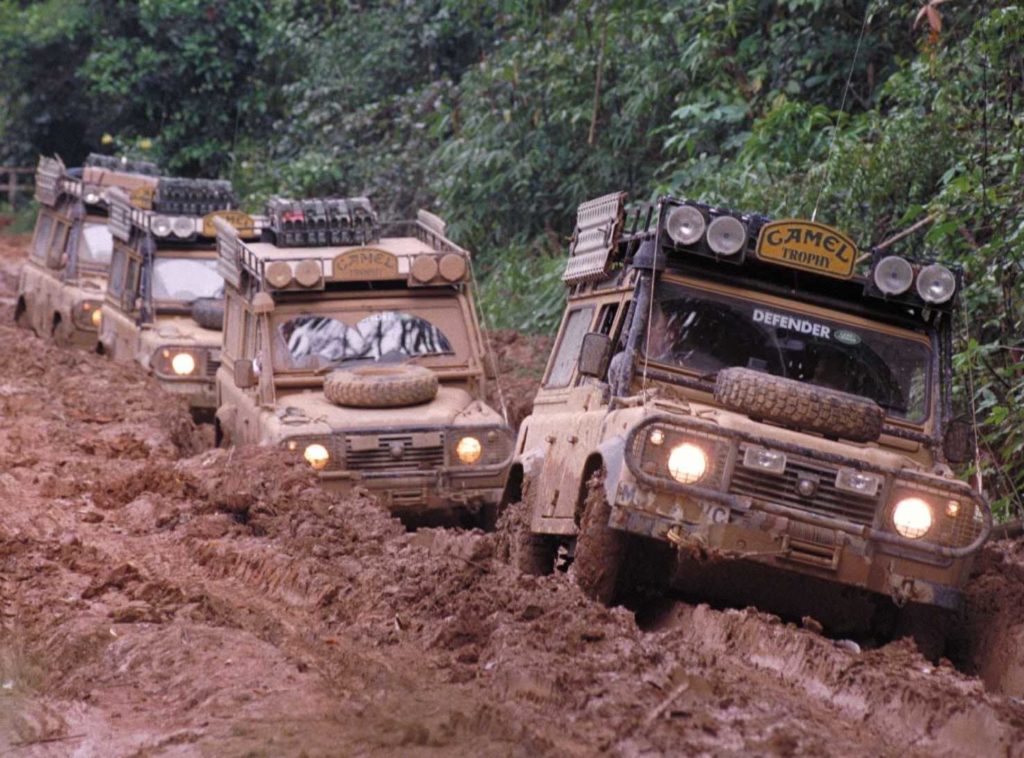
The first year was a modest affair planned as a ‘one off’. It arose when 6 enterprising German chaps sold the idea to Camel Cigarettes as a publicity stunt. The seed was sown and the next year was a little more sophisticated but still limited to 10 German competitors competing in specially prep’d V8 Range Rovers, duly stickered-up and painted an amazing bright Sandglow Yellow – the colour which survived to the very last Camel Trophy event and by which Camel prepared Land Rovers are recognised to this day.
In so doing Land Rover had unleashed new marketing potential, being the ability to illustrate Land Rover’s subtle shift in focus, moving from that of a pure ‘utility’ to that of offering the ultimate leisure or lifestyle vehicle. Nothing illustrates this better than the marketing strap line that was worked up alongside the Camel Trophy, which was “One Life … Live It”. A banner phrase that still adorns many enthusiasts Land Rovers to this day.
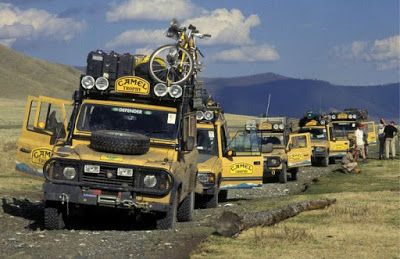
The first two Camel Trophy competitions under Land Rover’s sponsorship (1981 and 1982) were given over to the relatively new Range Rover. Thereafter each year teams were given a specially prepared Defender as their support vehicle. The team competition car was however selected from the most recently launched model in the entire Land Rover stable. So between 1983 and 1986 the Series III, One-Ten and Defender, in turn, took centre stage. However from 1987, the Defender had to step aside for others variants in the ever widening Land Rover range. That said, without exception, the support vehicle issued to each team (ie the true workhorse of the event) remained the Defender throughout.
Land Rover became synonymous with the Camel Trophy and rode a wave of public acclaim as each year the event rose to new heights. By the end of the 80’s over 1 million applicants sought to represent their country in the ultimate challenge of resourcefulness, physical endurance, mental strength and driving courage. The event had morphed into so much more than a straightforward endurance rally. The chosen terrain was inhospitable, teams had to navigate uncharted lands and get their sleeves rolled up in endless tasks, such as winching, rafting, orienteering, kayaking, mountain biking … and so the list goes on.
Today the Camel Trophy – and by extension its vehicles – have reached a near cult status amongst enthusiasts, giving birth to the Camel Trophy Owners Club where ‘the dream lives on’. The series was sadly brought to an abrupt end for Land Rover in 1998 when political sensitivities were such that a Global lifestyle brand such as Land Rover could no longer be seen to be associated with a cigarette brand.
Naturally, until the party was over, the mystique of the Camel Trophy was kept alive by the choice of exotic and challenging locations in which to test drivers and vehicles alike. The table below is a travelogue like none other, listing the location and winning team for each year of the Trophy series.
| Year | Location | Winning team |
| 1981 | Sumatra | West Germany |
| 1982 | Papua New Guinea | Italy |
| 1983 | Zaire | The Netherlands |
| 1984 | Brazil | Italy |
| 1985 | Borneo | Germany |
| 1986 | Australia | France |
| 1987 | Madagascar | Italy |
| 1988 | Sulawesi | Turkey |
| 1989 | The Amazon | UK |
| 1990 | Siberia USSR | The Netherlands |
| 1991 | Burundi – Tanzania | Turkey |
| 1992 | Guyana | Switzerland |
| 1993 | Sabah – Malaysia | USA |
| 1994 | Argentina – Paraguay – Chile | Spain |
| 1995 | Guatemala – Mexico | Czech Republic |
| 1996 | Kalimantan | Greece |
| 1997 | Mongolia | Austria |
| 1998 | Terra del fuego | France |
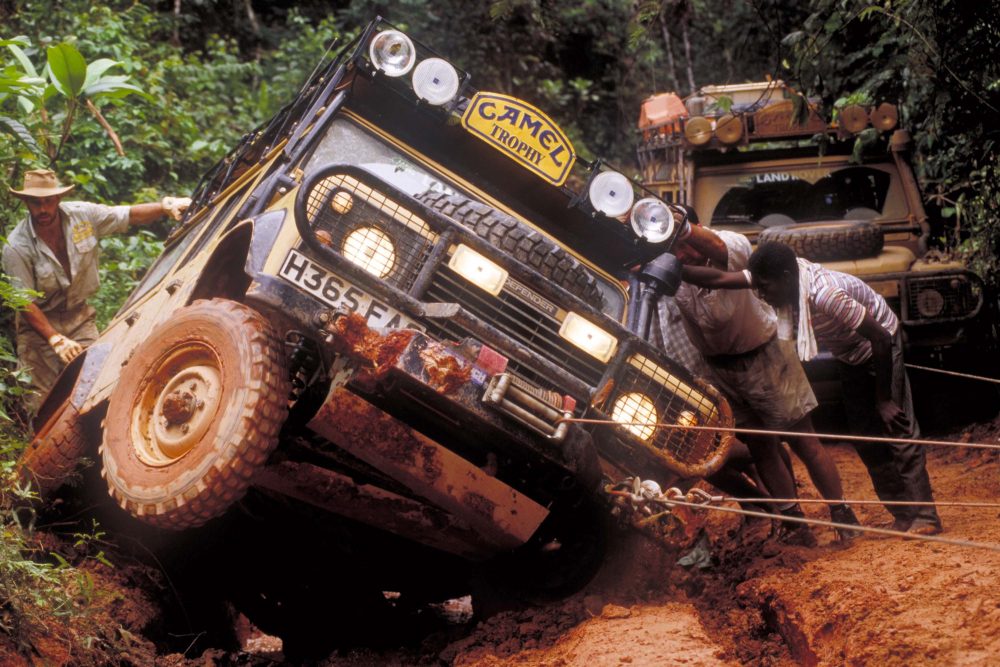
You will note that in only one year did a British team win. That team comprised two brothers, Bob and Joe Ives. They continue to be keen Land Rover enthusiasts and are often featured in the Landy magazines. More notable for us at LRHC, however, is that Bob was responsible for bringing our Series III Australian Tray Back over from Australia to work on his Hampshire farm before its retirement into our collection (exhibit WOR.06).
At the LRHC Trust we still aspire to acquire a Camel Defender of our own. Until that day we have to satisfy ourselves with the next best thing. The 1998 Japanese Team competition car, which is an initial year Freelander (exhibit EXP.01). The plucky Freelander surprised its critics as its relatively light weight manfully equipped it to deal with all that the extreme southern territories of South America could throw at it in the first (and last) Camel Trophy held in the winter months. There is no doubt that its successful showing in this, the most ‘grown up’ of adventure drives, secured acceptance of this new breed of Land Rover. Such is the power and influence of publicity!
A poor substitute
Withdrawal of the Camel Trophy from the Land Rover calendar created a vacuum that needed filling. Therefore 2003 saw the inaugural G4 Challenge. This was Land Rover’s own promotion and followed the general theme of the Camel Trophy, all be it slightly tamer in nature. 16 teams competed in driving and physical challenges held in four stages, each in its own time zone. They were competing for a first prize of a top-of-the-range Range Rover. The G4 vehicles were a very visible in Tangiers Orange with Black highlights. However the die-hards mourned the loss of the more familiar Sandglow Yellow of the former Trophy and, probably, nothing would leave them contented.
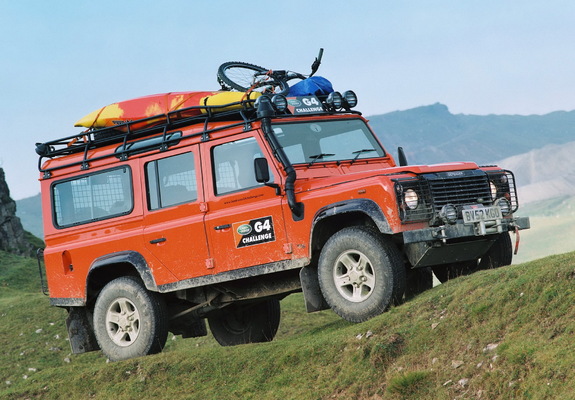
Significantly for us, the winner of the first G4 Challenge, Rudi Thoelen, turned down his prize of a shiny new Range Rover, swapping it for TWO Defenders … Top man. Respect!
The second G4 Challenge was held three years later and was more more arduous and focussed on driving skills and endurance behind the wheel as the number of peripheral activities fell by the way side. It took place in Thailand, Laos, Brazil and Bolivia.
In truth the G4 Challenge never matched the stature of the Camel Trophy and the third event due to take place in Mongolia in 2008 was cancelled due to the Global financial meltdown at the time. The G4 Challenge was never to return and, as a result, sadly never really came of age and never gained the recognition of that which had gone on before.
The final chapter of this adventurous story
As the Defender range was nearing the end of its life, gratuitous consumption of fossil fuels was a less desirable picture to present to the ever more socially conscious public. There had been for some time a need for Land Rover to embrace the social values of the moment and, amongst other things, that involved promoting protection of our Green Planet and a wider awareness of environmental sustainability. To this end, in 2008, a Bursary was created in conjunction with the Royal Geographical Society, supporting projects that (in their words) “promote a wider understanding or enjoyment of geography.” Contenders would pitch their ideas in the hope of receiving a cash grant of £30,000 together with a loan vehicle with which to persue their project. This was more than a cynical PR stunt. The involvement of the Royal Geographical Society kept it all very genuine. This Bursary has been awarded every year up until 2020, when the cycle was interrupted by the global Covid pandemic. And, of most interest to us, in all years up until 2016 the loan vehicle was of course a Defender 110.
Listed below are the expeditions that Land Rover sponsored under this scheme:-
2008 – Latitude Team – travelled along 50 degs North through Asia and Canada monitoring man’s adaption to his environment
2009 – Atlantic Rising – addressed the impact of rising sea levels by driving along the contour that prescribed land at risk
2010 – Fault Line Living – visited 5 locations around the World to observe man’s life and settlement where the Earth’s crust was fractured.
2011 – Glacier in a Greenhouse – Visited the Porisjökul Glacier in Iceland to study glacial matters
2012 – Pushing the Limits – took disabled adventurer, Andy Campbell, on an expedition from the UK to the Dead Sea
2013 – The Pole of Cold – A team tracked the onset of Winter across Europe to Siberia to arrive at the coldest place in the Northern Hemisphere where they were met by -40C temperatures
2014 – The Grand Alpine Tour – studied the impact of landslides at altitude across the length of the Alpine mountain ranges
2015 – Trail by Fire – saw a converted Defender laboratory visit 15 active volcanoes down the Andean spine of South America
2016 – Transcaucasian Expedition – spent 6 months in Georgia and Armenia mapping the first long-distance hiking trail along the Caucasus Mountain Range
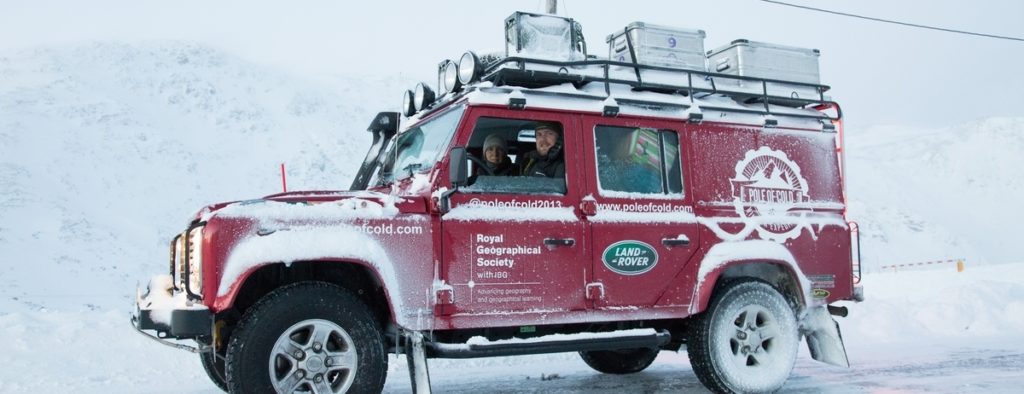
Of course the trips had a photogenic value to the PR men and the values that these expeditions espoused played into Land Rover’s desired narrative. But none of that detracts from two truisms. Firstly, if you venture into hostile terrain what better vehicle is there that the formidable Land Rover Defender to carry you there and safely home again. Secondly, notwithstanding all our concerns over the burning of fossil fuels, not everything concerning the automotive industry is bad!
In conclusion.
There need be no pretentious concluding revelation to this piece of writing. The actions of this laudable company and its remarkable vehicles speak loud and clear for themselves. But the writer does leave you with one final thought.
Do you not feel, when you see the parade of the gleaming 4×4’s waiting at the school gate, driven by their well coiffured drivers dressed in their designer tracky bottoms, that it is all rather incongruent? Those vehicles were bread to be in the mud and guts of the REAL world. Drivers and vehicles being tested by the terrain, the climate and the vegetation. Bringing enrichment and pleasure to those involved and those looking on. Just how much of those urban mis-fits’ design capabilities are ever put to the test? I think we all know the answer to that question.
So when the dust clouds settle for the last time on those well travelled Series Landy’s and Defenders and as Land Rover takes the Defender range off into new directions, something tells me that we will mourn the loss of these uncomfortable, rattly, characterful (yet intrepid) vehicles so much more than the eventual demise of the proverbial ‘Chelsea tractor’. Incidentally, the irony being that the latter only gained their kudos by association with these ruffians! So if your 4×4 spends most of its life shuttling between home and school, before its too late put the thought of the school fashion parade behind you, where would you rather be (or be seen) in your Land Rover? How about here in the High Himalyas, perhaps?
